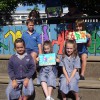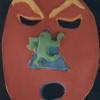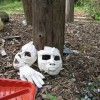- Keith Haring Murals in San Sebastián
- Keith Haring Murals
- Come To Know Keith Haring
- Organ Systems Mural
- City as Canvas: Artist Spotlight
- Printing with Objects
- Mural Making in the Style Of Keith Haring
- Subway Graffiti Project
- T-shirt Designer
- Keith Haring Semiotics Poster
- Introducing Keith Haring
- Discovering Keith Haring
- Haring Inspired Mural
- All Bottled Up!
- Thinking about Drawings as Symbols
Curriculum | History
City as Canvas: Artist Spotlight
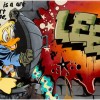
This guide is intended to be used as a resource for teachers either preparing to visit the Museum of the City of New York’s City as Canvas: Graffiti Art from the Martin Wong Collection or to use in the classroom following a class visit.
During the gallery tour of the City As Canvas exhibition, students will view highlights from the Museum's rich collection of 1970s and '80s graffiti art in New York. By analyzing the drawings, paintings, photographs and blackbooks collected by Martin Wong, students will learn about New York City artists known as “writers”, like Keith Haring, Lady Pink, Lee Quiñones, and Daze, and the historical context in which their work was created. Students will be able to elaborate on the multiple perspectives surrounding street art, discuss the various styles represented, and will respond creatively to the pieces by drafting their own sketches.
The information and activities in this guide correlate to the guided tour, but may also be taught as stand-alone lessons utilizing the text, images, and suggested activities. Teachers are encouraged to adapt the information to the grade level and ability of their students. For further information or to schedule a visit to the Museum of the City of New York, please email the Frederick A.O. Schwarz Children’s Center at schoolprograms@mcny.org
Studying Mural: “Crack is Wack”
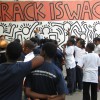
Haring's 2-sided mural on a handball court at 128th Street & 2nd Avenue in NYC overlooks the FDR drive. A public site that has brought much acknowledgement since it was painted in 1986. This lesson, organized collaboratively with The Children's Storefront gives local students the opportunity to examine and reflect on one of Haring's most influential landmarks.
Art & The Berlin Wall
This lesson, developed by a graduate student at the University of New Mexico, explores the relationship between Cold War politics, the people who were affected by it, and the artists who examined it. Using the Berlin Wall as a focal point, students have the opportunity to create their own "walls".
Lessing meets Haring
This elementary school in Germany partnered up with some college students to create a challenging mural that functions as visual storytelling and encourages graffiti prevention.
The 1980s Series – Graffiti
During the 1980s, music, dance, fashion, and art experienced a boom of energy and innovation. It was also during the 80s that Haring came into prominence and produced most of his signature work. This series of lessons seeks to explore the cultural and creative phenomenons of the 1980s for the youth of today. The Graffiti project seeks to create an open & constructive forum for students to communicate their thoughts and feelings by creating a "graffiti wall" within the classroom.
The 1980s Series – Fashion
During the 1980s, music, dance, fashion, and art experienced a boom of energy and innovation. It was also during the 80s that Haring came into prominence and produced most of his signature work. This series of lessons seeks to explore the cultural and creative phenomenons of the 1980s for the youth of today. The Fashion lesson allows students to transform old clothes, model them and reflect on the process while having fun and being creative.
